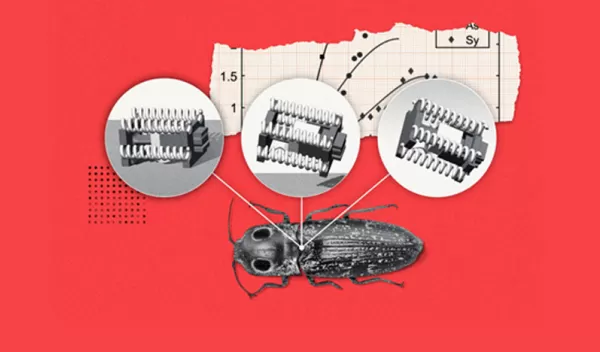
Click beetle-inspired robots use elastic energy to jump
Researchers at the University of Illinois Urbana-Champaign have made a significant leap forward in developing insect-sized jumping robots capable of performing tasks in the small spaces often found in mechanical, agricultural, and search and rescue settings.
A new study led by mechanical scientist and engineer Sameh Tawfick demonstrates a series of click beetle-sized robots small enough to fit into tight spaces, powerful enough to maneuver over obstacles and fast enough to match an insect's rapid escape time.
The findings are published in the Proceedings of the National Academy of Sciences. The research was supported in part by the U.S. National Science Foundation through a grant to Princeton University's Aimy Wissa, one of the authors of the paper.
Over the past decade, researchers at Illinois and Princeton have studied the anatomy, mechanics and evolution of the click beetle. A 2020 study showed how the beetle uses muscles to bend its body and locks in that stored elastic energy with an anatomical structure called a thoracic hinge. When the beetle needs, for example, to escape a predator, it unlatches the hinge, allowing its body to unbend rapidly and propel it into the air many times higher than its body length.
"One of the grand challenges of small-scale robotics is finding a design that is small, yet powerful enough to move around obstacles or quickly escape dangerous settings," Tawfick said.
In the new study, tiny, coiled actuators gradually compress a beam, causing it to slowly bend and store elastic energy. Actuators are to robots what muscles are for animals — they are the components that enable movement by converting energy into mechanical force.
A rapid shape change, called snap buckling, is triggered to suddenly release the stored energy, causing the beam to sharply strike the ground and propel the robot upward.
"This process, called a dynamic buckling cascade, is simple compared to the anatomy of a click beetle," Tawfick said. "However, simple is good in this case because it allows us to work and fabricate parts at this small scale."
Guided by biological evolution and mathematical models, the team built and tested four device variations, landing on two configurations that can successfully jump without manual intervention.
The team envisions these robots accessing tight spaces to help perform maintenance on large machines, for example, turbines and jet engines, by taking pictures to identify problems.
"We also imagine insect-scale robots being useful in modern agriculture," Tawfick said.
Jordan Berg, a program director in NSF’s Directorate for Engineering, said that "these researchers are inspired by nature to create elegant and innovative engineering solutions. They have shown that relatively slow, contractile actuators can drive the extremely fast and powerful leaping movements of a small-scale robot."
